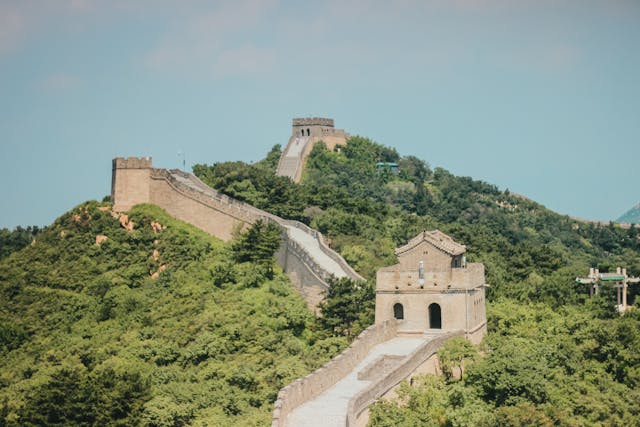
Why was the Great Wall of China built? It was built to protect the territory of the new Chinese empire, to protect the silk road, because the labor was available, the emperor wanted to be remembered, and as a show of power.
The official length of the Great Wall of China is 21,196.18 km long. However, that is not one continuous wall. We say the Great Wall of China, but the Great Walls of China might be a more appropriate name as the whole thing is a collection of shorter walls that were all built at different times. The wall has been added to by different rulers over the two thousand years since it was started. Some parts have been removed, some parts have fallen down, and some parts are possibly lost.
Emperor Qin Shui Huan is the emperor most closely associated with the beginnings of the Great Wall. There were a lot of shorter walls that already existed at the time and Qin looked at them and realized they could be joined together into a much longer and much more formidable wall. Emperor Qin is the first emperor of China because he unified the country. China was an empire for over two thousand years before it ended in revolution. Qin started the Chinese empire but he is not viewed favorably by everyone. He was a visionary, but he was brutal and a lot of people died on his journey. We probably know him for the Terracotta Warriors that he had built to guard his tomb and for the Great Wall of China that he started.
Qin Huan was born in 259 BC, and he became king of the Qin state. At the time, China was divided into 7 different kingdoms. Qin was 22 years old when he became king and by the time he was 37, in 221 BC, he had defeated all of the tribes and unified all of China. He reformed China and although his dynasty didn’t last that long, his ideas and the things he left did.
Qin gave orders to start building the wall in 221 BC. He wasn’t the first person to build a wall and there were already several walls that had been put up by each of the tribes before him. They had built them along natural lines in the geography and there several hundred kilometers of wall in about 10 different locations throughout Emperor Qin’s new China. Qin had most of the original walls pulled down because with them standing, his unified China would always feel separated. He then had a long wall along the northern border of China built. It was built out of rammed earth and rocks, and not the brick that we see today. Rammed earth is constructed by putting wet earth into a frame. The earth is then compressed (or rammed) until it is half its volume, and it is left to dry. The resultant earth is hard and sturdy. The wall that Qin built was roughly 5,000 km long, which is a length given by the wall’s name in China. It is called the 10,000 li long wall. A li is a measurement of distance that is roughly 500 m.
So, why was the wall built? The main reason why Qin started the wall was to protect the new territory of China. The original walls had been built to protect each kingdom in warring China from the other, but Emperor Qin didn’t need to worry about other Chinese kingdoms because he had conquered them all. His worries lay to the north. He was concerned with the nomads who lived on the plains of Inner Asia, some of whom would go on to become the Mongols with an empire of their own. After the Qin dynasty had passed, future dynasties continued to add to the wall. Their reason was still for protection. By the start of the 1st century BC, a lucrative trade route with Europe had arisen and emperors wanted to protect this at all costs.
The wall was also built because there was a huge amount of slave labor available. Starting with the Qin dynasty, slavery was used as a form of punishment and control. Anybody could be taken as a slave for a crime, or a slight against an official, and there was an enormous slave workforce. Qin used them to build the wall and the other monuments he left. Future emperors also had access to a lot of slaves and so building continued.
Another reason was that emperors wanted to be remembered. The Roman emperors, and kings and queens throughout history have always done this. If you want people to remember you, build something and put your name on it. Building more of the great wall became a status symbol for the emperor. In fact, building continued until 1644, when the Ming dynasty ended. The Ming dynasty built all of the stone walls that we see today. There was no more building after 1644 because China had extended its borders far beyond the wall and it was no longer a wall along the northern border of China.
The last reason that the Chinese built the great wall was as a symbol of power. Being able to raise the money and the manpower to be able to build such a structure was no easy feat and the sheer size of the project showed how powerful the Chinese were. And this is what I learned today.
Photo by Mackenzie Ryder: https://www.pexels.com/photo/an-aerial-photography-of-great-wall-of-china-under-the-blue-sky-6440083/
Sources
https://www.thecollector.com/who-built-the-great-wall-of-china-and-why
https://www.liverpoolmuseums.org.uk/stories/who-was-chinas-first-emperor
https://education.nationalgeographic.org/resource/great-wall-china
https://en.wikipedia.org/wiki/Li_(unit)
https://www.archdaily.com/933353/how-rammed-earth-walls-are-built
https://en.wikipedia.org/wiki/History_of_the_Great_Wall_of_China
